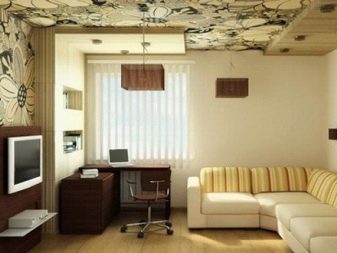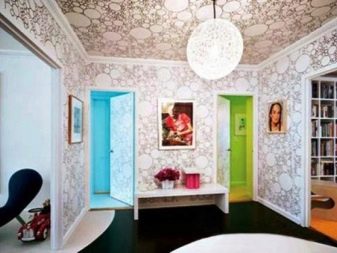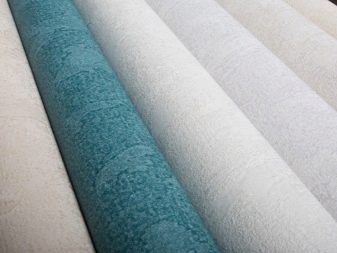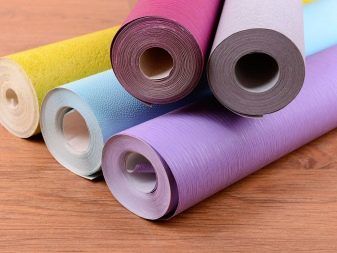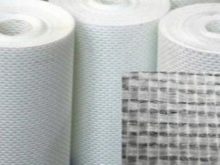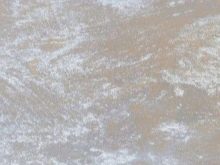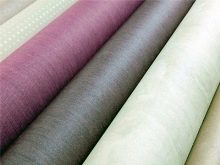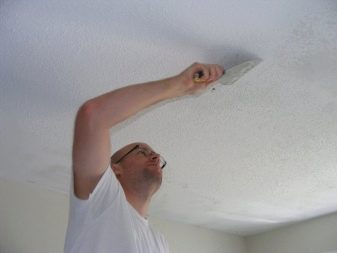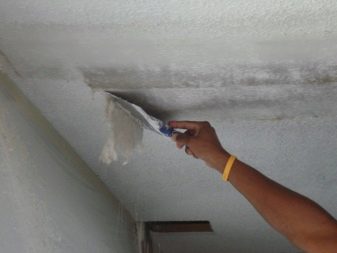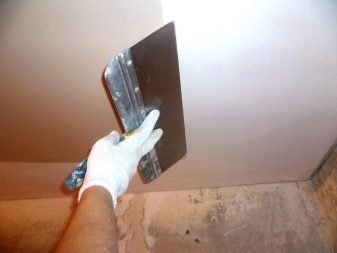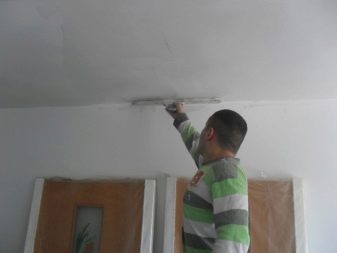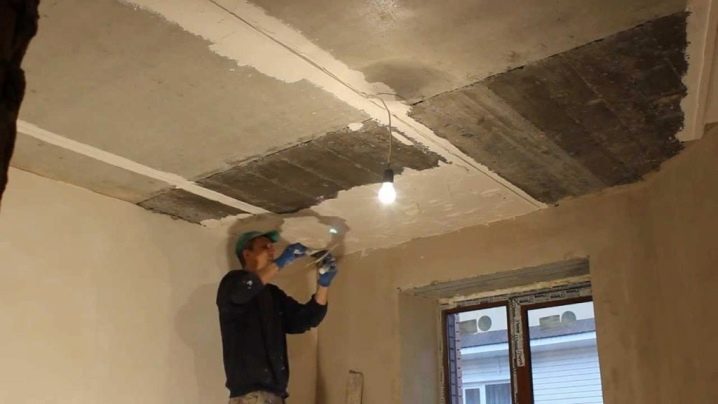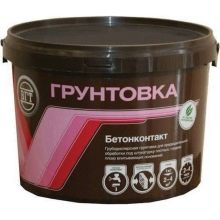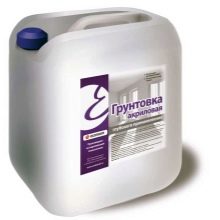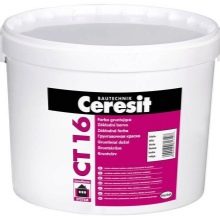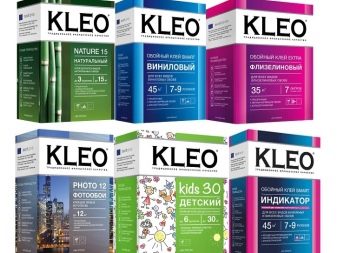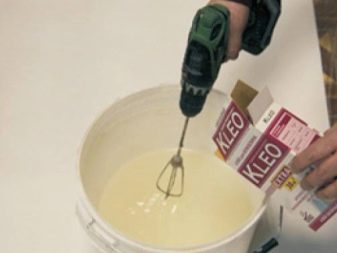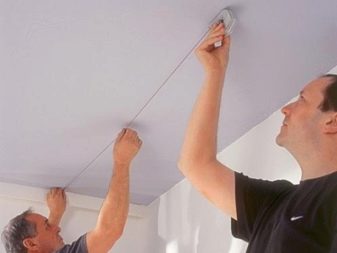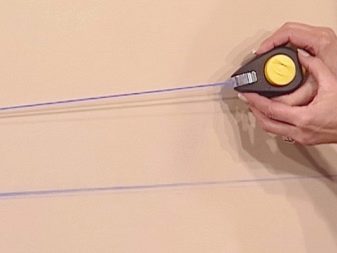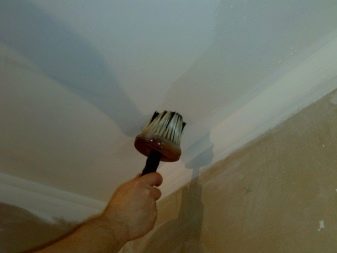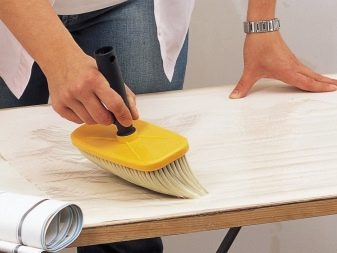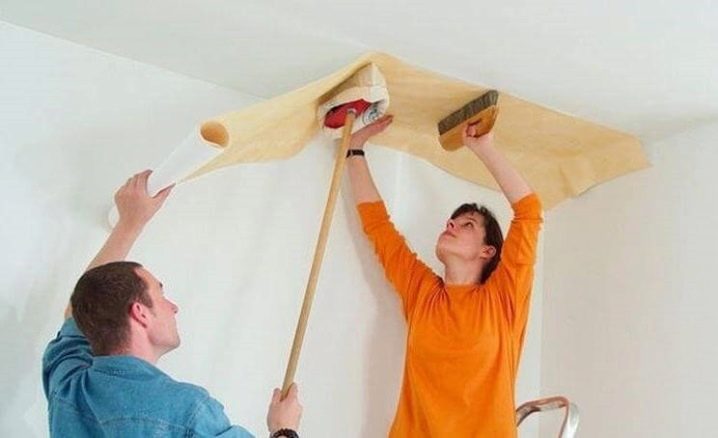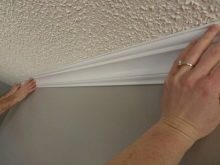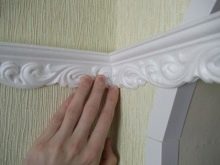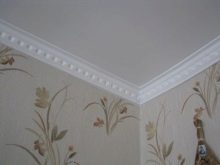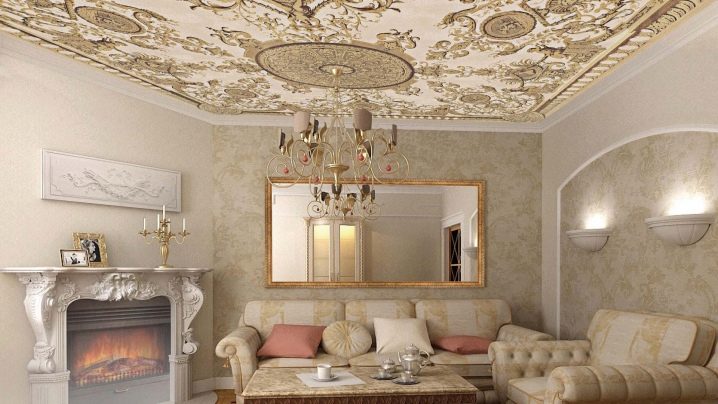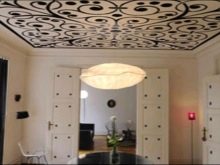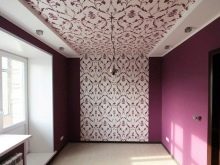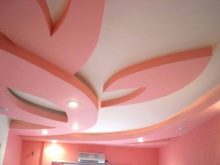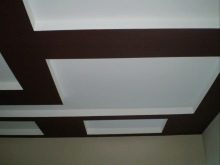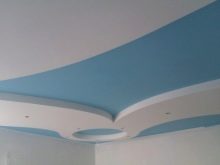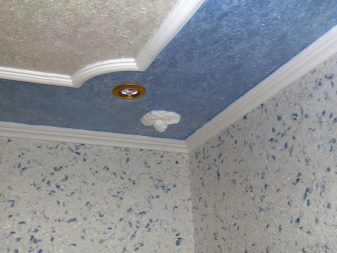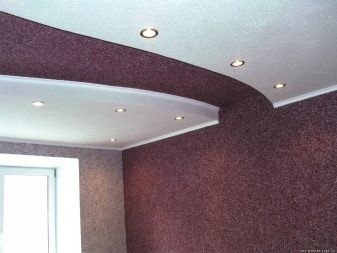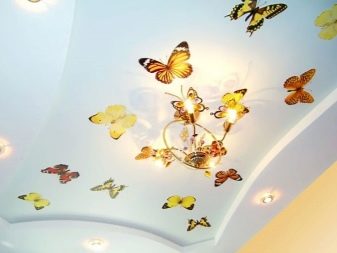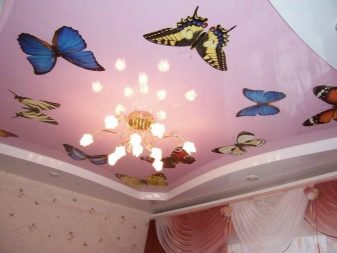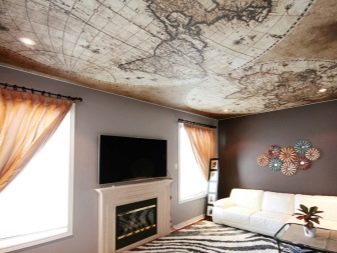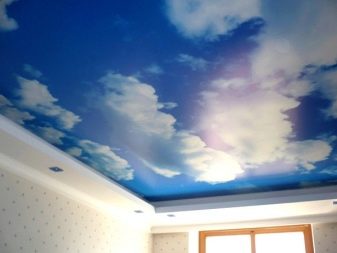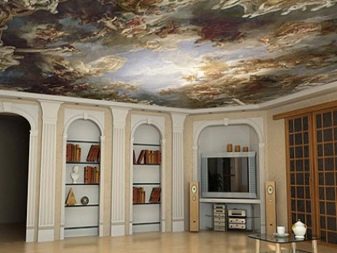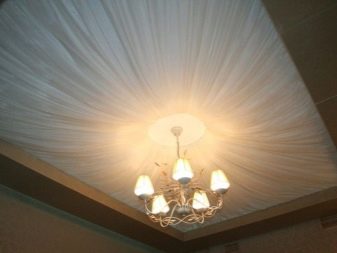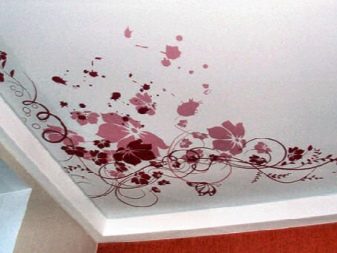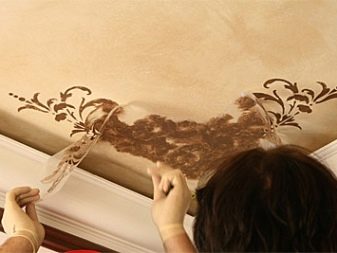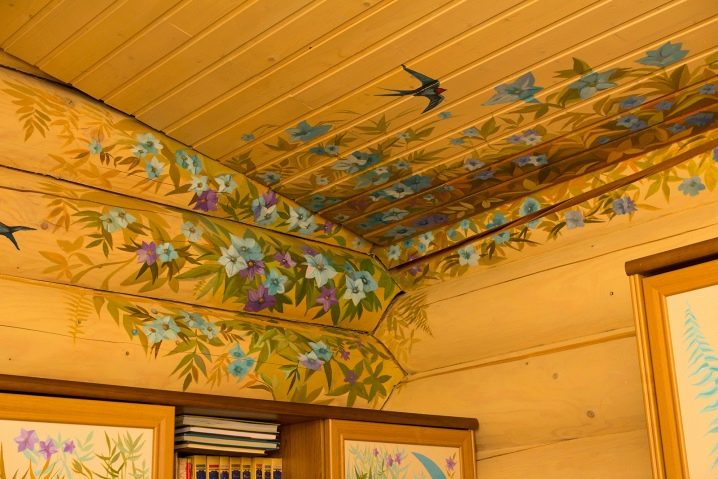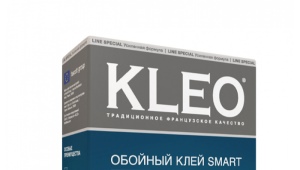Rules and recommendations of wallpapering on the ceiling
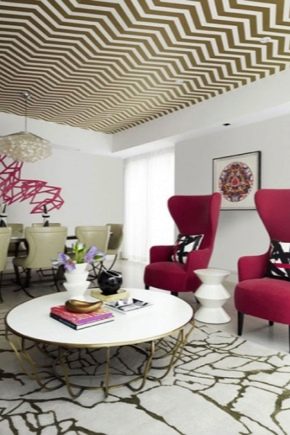
The ceiling can be arranged in different ways: to entrust the installation of a hinged to professionals, to use drywall, to lay out the tile, to whiten, to paint, to glue the wallpaper. If you choose the latter option, you should know that there are certain rules and recommendations for wallpapering on the ceiling. And if you listen to them, then, of course, cope with the task, regardless of its complexity.
Types of wallpaper
Depending on the material of manufacture, today the following coatings are presented:
- Traditional paper - the easiest option. However, it should be borne in mind that not all rooms they fit. In the bathroom and kitchen you will have to change them very soon.Therefore, leave the paper sheets for rooms where there is no moisture and steam.
- Vinyl differ original designs, all kinds of reliefs, a variety of colors. Ceiling flaws are eliminated during pasting. Vinyl wallpapers are so durable that they can withstand wet cleaning and do not fade from sunlight, in addition, they are scratch resistant.
But it should be remembered that at high humidity there is a risk of the formation of fungus and the occurrence of mold. To prevent this, it is first necessary to apply an antiseptic to the ceiling and then prime it. You do not need to apply glue to the wallpaper, only on the surface prepared for work.
- Non-woven wallpaper also amenable to wet cleaning, they can be used for painting. They are quite suitable for the bathroom.
- In addition to non-woven, you can use fiberglass wallpaper. They are able to withstand up to twenty stains. They consist of natural materials. They are so durable that the life of this coating reaches 30 years.
- Traditional wallpaper can be replaced and liquid. They also have their advantages. Besides the fact that they are environmentally friendly, resilient and antistatic, any damaged area can be replaced with a new one, and this will not be noticeable.
Ceiling preparation
The stage is very responsible, on which the success of the whole event depends. Excess items must be removed from the premises in advance. Ceiling lights unscrew, bare wires wrap tape. The same goes for switches and sockets. The windows should be closed, as drafts are unacceptable when performing these works.
Next, you need to carefully prepare the ceiling for sticking wallpaper:
- Before we properly clean the surface. We take into account the type of pollution. Wet soaked ceiling with a sponge, soap solution and any cleaning products. You may have to do this several times.
- We are waiting for complete drying. Then we coat it with a deep penetration primer. And only after all these procedures proceed to the putty.
- Old oil paint must also be removed. Will help in this iron sharp spatula. Be sure to protect the eyes and respiratory masks from harmful dust and pieces of paint that will fall from the ceiling. At the end, the entire area is sanded with sandpaper to remove residues.
- It is recommended to use special formulations that are sold in hardware stores.We process the necessary area with them, the paint softens under the influence of chemicals, we remove the mushy mixture with a rag. You can also use a grinder with special nozzles. Choose the way that you think is most convenient.
- Provided that the ceiling is whitewashed, we remove the lime with a spatula. After that, wash off the remnants of a soap solution.
- Next is to align the entire area. Plaster and putty will help with small irregularities. They will cope with small rough edges and cracks. If the disadvantages are more pronounced, remove the curvature using drywall and profile.
- With the help of mounting tape we process joints between sheets. Having sealed the seams, we will be sure that after some time, no cracks will form here. After that, we putty and sand the ceiling with sandpaper to avoid the formation of small bumps.
Some are wondering - is it possible to glue wallpaper onto a tile? No matter how firmly it holds, such a repair will not serve you for a long time. Wall-paper can lie unevenly, over time subside and crack the joints and in some places move away.If you do not want all this, it is better to spend time and energy and get rid of the tile in advance.
If you want to update old wallpapers by sticking others on them, this is also a bad option. It happens that the paper coating keeps very tight. But over time, under the influence of glue and another thick layer, they can still begin to move away. And then there will be more problems.
Do a simple experiment. Wet a small area well and check how the old wallpaper will behave after drying. You will see at least small bubbles, which means that you need to clean this wallpaper.
Wooden ceiling requires special preparation, there are some subtleties. First, we treat the surface with a primer, then we putty. When dry, primed again. Only then can you stick the wallpaper.
Priming
Finally, you cleaned the ceiling of old paintings, tiles, dirt, lime, plastered and allowed to dry, it's time to start the primer. Special compounds improve the adhesion of building materials.
Therefore, it is necessary to prime the ceiling if you want the wallpaper to stick well and hold as long as possible on the surface.
The range of primers varied. There are cheaper ones. Some prefer to use those that contain components that can prevent the formation of fungus and mold. The primer is applied with a roller, brush and spray. Some compounds need to process the ceiling several times.
What to glue?
Use the composition, which is intended for a specific type of wallpaper. If it is paper, the usual one will do. For non-woven choose only the one that is intended for heavy wallpaper. We act according to the instructions that are on each package.
We dissolve the glue in the same way as for the walls. Gradually pour out the dry powder in a thin stream, stirring continuously. Then, using a mixer, we achieve a homogeneous mass without lumps. Divorced glue stored no more than five days, having previously well closed the container.
Accordingly, special formulations are used for liquid and glass wall coatings. Some use old proven paste and cook it themselves. But this method is only suitable for paper wallpaper.
Features of the pasting process
Self-glue wallpaper on the ceiling is not so easy. Therefore, it is better to do it together.When the surface is clean, dry and fully prepared, you can proceed.
Many immediately have a question: where to start. It will be correct if to paste cloths along side walls. Then the joints will not be visible in daylight.
First you need to apply the markup on the entire surface. Measure the width of the roll from the side wall (it is better to use meter wallpaper). Do the same on the other side, draw a line with a ruler and a pencil. At the joints of the wallpaper, it is permissible to use paper masking tape, which will further save from the peeling of the wallpaper.
Making the layout of the wallpaper in the roll, pay attention to what is your picture, whether you need it customized. Number all received sheets and fold in the correct order.
Spread the sheet with glue and let it soak. Treat the part of the ceiling to be pasted. Coat the corner thoroughly and at the joints.
Then attach the first sheet to the ceiling and roller out from the middle to the edges. Moving from the inside of the room to the window. If the walls are rounded, then you will have to tinker with the corners. We'll have to make small cuts on the wallpaper, so that they are conveniently located on the surface.
Wipe excess glue with a soft cloth, carefully watch so that bubbles do not form. Where there are lamps and chandeliers, make a neat cut in the form of a cross, thread the wires and press the wallpaper tightly to the ceiling. When pasting is completed, evaluate the result. Pay attention to whether there are no glued pieces and bubbles.
For more information on how to glue wallpaper on the ceiling with your own hands, see the following video.
Sticking decors
Baguettes not only decorate the ceiling, but also hide some defects at the joints. There are two options for sticking. In the first case, ceiling skirtings are glued, and then wallpaper. In the second case, baguettes are glued on top of the wallpaper, which is much more complicated.
In order for the ceiling to look beautiful, you need to buy a special glue, cut the planks well and smoothly. And for this it is better to purchase a special device for cutting - stouslo.
There are many decorative elements that will decorate the ceiling. It all depends on your imagination and skill. It can be decorative beams - plaster, polyurethane, foam. The ceiling can be decorated with decorative plaster.
Sockets will be appropriate - these are elements of stucco molding.They are fixed near the chandeliers and lamps.
Tips and tricks
Consider several important factors:
- 110 g / m2 - the maximum allowable density for ceiling wallpaper. In a small room would be appropriate monophonic or with a small pattern. Leave large prints for large rooms and high ceilings. If the ceiling system is multi-level, there is a reason to experiment with wallpaper of different textures. And most importantly, make the correct calculations, note that the drawing will have to be customized.
- Hide flaws, visually change the space will help competent decor. It is not necessary to invite professionals, you can solve this problem yourself. The main thing is to understand what you prefer. The easiest way to paint, and, as one of the options - choose paint of different colors and thus divide the room into zones with the multifunctionality of the living room.
- Another way to achieve the same effect is to glue the ceiling with wallpaper of two types, deciding which plots to choose one or another texture.
You can glue applications, but this is applicable for children. It also makes it possible to hide irregularities or even blemishes. Buy ready-made stickers or make them your own hands - you decide.
Successful examples and beautiful options
Modern design has no boundaries. Thanks to the original design of the ceiling, you can make any room unusual. When sticking wallpaper in the hall, bedroom, nursery, you can consider this option as wallpaper.
With the help of fabric you can transform any ceiling, and with it the whole space.
There are other ways. You can do your own stencils. Occupation fascinating for both adults and children.
Multi-layer and interesting design with the use of various elements can be created from drywall. Exotic lovers can choose something extravagant, for example, bamboo decorations or oriental style. If you have the talent of an artist, you have a great opportunity to make your ceiling a work of art and draw bright flowers or seascape there.
In general, sticking wallpaper to the ceiling and decorating with various materials is a very exciting job. Do not forget to take into account all the nuances, and your ceiling will delight you and delight guests.
